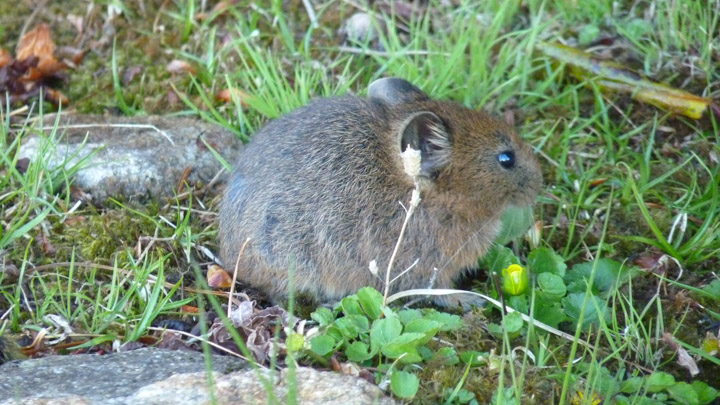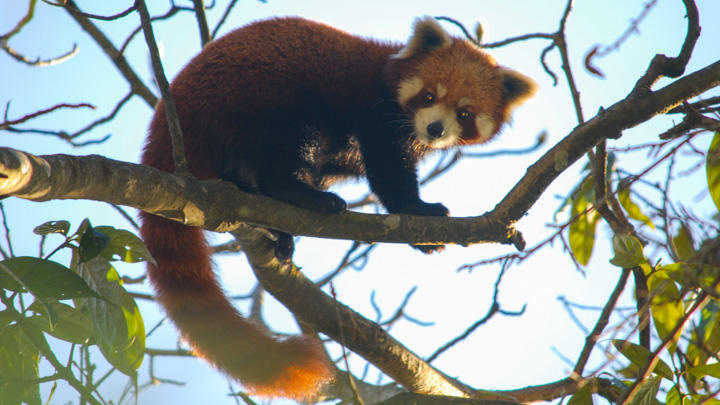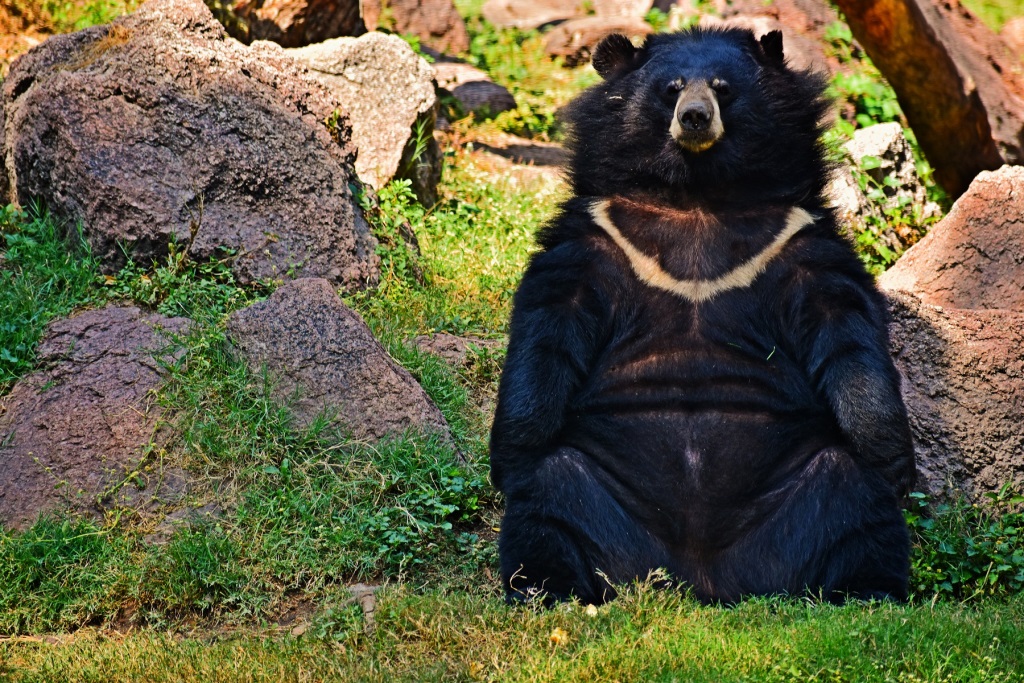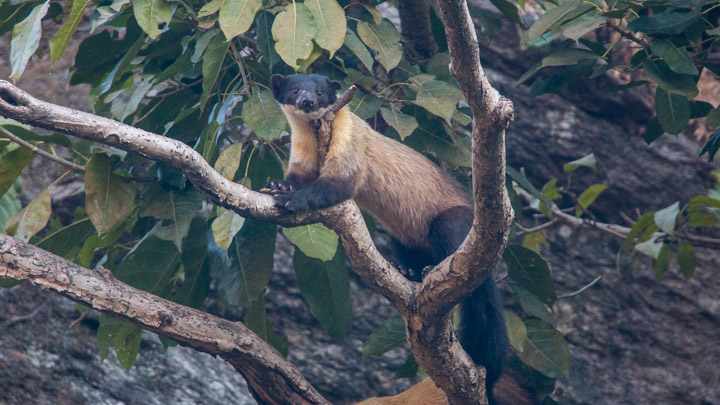
The Everest Region has quite a few interesting animals, from the inquisitive Pika to the majestic Snow Leopard. And while animals are generally hard to see, you can increase your chances of encountering them if you go there during the winter months of January and February.
Here are some mammals you can expect to see. (Please note that we have a separate post for the Birds of Everest Region.)
Musk Deer

We think it’s about time biologists change the name for these guys to saber-toothed deer. First, the name will instill fear rather than greed on people looking to poach these beauties for their musk glands. Second and more importantly, we think saber-toothed deer is so much more badass for a name than musk deer. On a more serious note, the $45,000 that a kilogram of supposedly aphrodisiac musk fetches in the world’s luxury markets has brought these guys close to extinction. It is a shame that these guys have to pay the price for people who can’t attract people on their terms.
Best Place to See in the Everest Region: around Deboche, Tengboche, and Phortse.
Snow Leopard

Consider yourself blessed by the mountain deities themselves, if you get a glimpse of this elusive, almost chimerical animal. They epitomize the grandeur and mystique of the Himalayas. They are, however, very rare. And if you don’t get to see one, we hope the beautiful image provided by the Snow Leopard Conservancy comes as some consolation. This dedicated and experienced group of researchers and citizen scientists are hard at work to decrease the human-leopard conflict, which is the most critical reason for this animal’s dwindling population. If you think these beautiful and endangered animals deserve a chance, feel free to contribute to SLC.
For your viewing pleasure, here is a Snow Leopard sighting at Jorsalle (2,850 meters). The footage is from spring 2021.
🐆 @mtnsofmymind sent me this video of close encounter with snow leopard at an altitude of 2800m, Jorsalle, Sagarmatha National Park. Been to this area so many times yet never expected/seen any of these wild cats. #SnowLeopard #Nepal pic.twitter.com/mXy3KA4xLd
— North (@callmeniraj) June 9, 2021
Best Place to See in the Everest Region: Gokyo.
Himalayan Tahr

These hardy mountain goats make light of the impossible cliffs they call home. While both the males and females are horny, only the males put the horns to good use during the breeding season in winter. The vicious fights that break out during such an annual rut frequently result in the death of one or both competitors.
The Everest Region is perhaps home to one of the densest concentrations of these animals in the Himalayas. And all thanks to the Sherpa tradition of not disturbing wildlife, they are pretty tame.
Best Place to See in the Everest Region: Section between Phortse and Pangboche, and area around Kyangjuma.
Marmots

Furry, chubby, and chocolate brown, Himalayan Marmots are adorable. They live in extended family units that may join together to form colonies, the size of which depends on the resources available. In some cases, a colony can contain up to 30 families. And these guys dig unusually deep burrows to hibernate in winter.
Marmots live primarily on a diet of herbaceous plants and grasses. However, this species may also eat fruit or grain from time to time if they are available as well as roots and the leaves of plants.
Upon being approached, they give out a series of quickly uttered alarm calls. They then sit up on their haunches to look around. And if it calls for it, off they go back into their burrows screaming a loud whistle.
Best Place to See in the Everest Region:
Pika

These impossibly cute guys are regularly encountered in the Himalayas. They are very often very curious and repeatedly come close to human beings only to run away immediately afterward. Despite living at such high altitudes year-round, they do not hibernate but instead hoard food for limited times.
Best Place to See in the Everest Region: Between Namche and Pangboche.
Red Panda

The Red Panda, or Firefox, is a beautiful animal that frequents forests with cane bamboo thickets. Shy and retiring, these animals are tough to see. Unfortunately, people are willing to pay a premium for their fur, which almost pushed these guys to the brink of extinction. Legally protected now, they are finally making a comeback in a small way in Nepal.
One of the best ways to see these rare and retiring animals is to join one of the Eco treks run by the Red Panda Network. This double whammy of a trek raises the chances of survival of these animals while at the same time ensuring that you have a one of a kind trek.
Best Place to See in the Everest Region: Area around Jorsalle.
Himalayan Black Bear

While nowhere as large as the grizzlies, they can nevertheless be 6 ft tall. It is the one animal that I hope you won’t encounter up close as they are rather aggressive and have very little fear of man. Remember that these guys are expert climbers, so in case of a close call, never for a second think that a tree will come to your rescue. Instead, it is advisable to avoid eye contact and slowly and calmly increase your distance from one. But don’t worry too much such encounters are very, very rare.
Best Place to See in the Everest Region: Area below Namche.
Nepal Gray Langur

These guys are close relatives of the Hanuman Langur from the lowlands. Hanuman is the Hindu monkey god who is revered for his strength. Furrier and more massive than their lowland cousins, it is advisable not to approach these guys during the springtime when certain wildflowers can make them irritable. Otherwise, they are a rather tame bunch.
They are also one of the few animals that practice infanticide. Once a bachelor group overthrows an alpha male with a harem, the successor will kill off all the infants that haven’t been weaned. He will also kick off the rest of his bachelor group members. Humans aren’t, after all, the only species that practice infanticide. While elaborate cultural rituals often masked human infanticide, the purpose was almost always to manage meager resources or doubt over parenthood. The fact that infanticide is now much less common speaks volumes for how far human beings have progressed in creating and utilizing natural resources.
Best Place to See in the Everest Region:
Mountain Weasel

These quick and furtive weasels can be seen around rocky places trying to corner a wren or pika. Despite looking relatively harmless, they are fierce hunters and are even more aggressive when defending their territory, especially during their breeding season in early spring.
Best Place to See in the Everest Region: Pheriche, Lobuche, Gorakshep.
Yellow-throated Marten

Inhabiting hilly forests, these are small weasels with over-sized courage. Hunting in pairs, these guys have been known to bring down deer several times their size. They are also known for mindless ferocity when they get the chance. For example, if these guys get into a chicken coop, they are likely to kill as many birds as they can but only carry a few.
Best Place to See in the Everest Region: Area below Namche.
Checklist of the Mammals of Sagarmatha National Park
Source: Thakuri, S. (2009). Distribution of Key Mammals in Sagarmatha National Park. Master’s Thesis.
|
SN |
Animal name |
Scientific name |
|
1 |
Asian wild dog |
Kuon alpines |
|
2 |
Bobak marmot |
Marmota bobak |
|
3 |
Brown toothed shrew |
Soriculus caudatus |
|
4 |
Common langur |
Presbytis entellus |
|
5 |
Common leopard |
Panthera pardus |
|
6 |
Golden jackal |
Canis aureus |
|
7 |
Goral |
Naemorhedus goral |
|
8 |
Grey wolf |
Canis lupus |
|
9 |
Himalayan black bear |
Selenarctos thibetanus |
|
10 |
Himalayan musk deer |
Moschus chrysogaster |
|
11 |
Himalayan pika |
Ochotona himalayana |
|
12 |
Himalayan serow |
Capricornis sumatraensis |
|
13 |
Himalayan tahr |
Hemitragus jemlahicus |
|
14 |
Himalayan water shrew |
Chimarrogale himalayica |
|
15 |
Himalayan weasel |
Mustela sibirica |
|
16 |
House mouse |
Mus musculus |
|
17 |
Masked palm civet |
Paguma larvata |
|
18 |
Muntjac |
Muntiacus muntjak |
|
19 |
Rat |
Rattus sp. |
|
20 |
Red fox |
Vulpes vulpes |
|
21 |
Red panda |
Ailurus fulgens |
|
22 |
Royle’s pika |
Ochotona roylei |
|
23 |
Sambar deer |
Cervus unicolor |
|
24 |
Short-nosed fruit bat |
Cyanoptera sphinx |
|
25 |
Short-tailed mole |
Talpa micrura |
|
26 |
Snow leopard |
Uncia uncia |
|
27 |
Stone marten |
Martes foina intermedia |
|
28 |
Tibetan water shrew |
Nectogale elegans |
|
29 |
Wild yak |
Bos grunniens |
|
30 |
Woolly hare |
Lepus oiostolus |
|
31 |
Yellow-throated marten |
Martes flavigula |
Are you interested in wildlife photography or wildlife tours in the Everest Region?
Please send us a message on WhatsApp, or you can fill-up the form below:-







